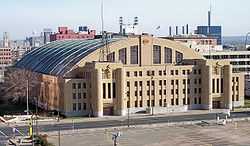PWA Moderne

PWA Moderne (or "P.W.A. Moderne", PWA/WPA Moderne,[1] Federal Moderne,[2] Depression Moderne,[1] Classical Moderne,[1] Stripped Classicism) is an architectural style of many buildings in the United States completed between 1933 and 1944,[2] during and shortly after the Great Depression as part of relief projects sponsored by the Public Works Administration (PWA) and the Works Progress Administration (WPA).
The style draws from traditional styles such as Beaux-Arts classicism and Art Deco and is similar to Streamline Moderne[2][3] but with zigzag ornamentation added. The structures reflect a greater use of conservative and classical elements and have a monumental feel. They include post offices, train stations, public schools, libraries, civic centers, courthouses,[2] museums, bridges, and dams across the country. Banks were also built in the style because such buildings radiated authority.[1]
Elements of the style
Typical elements of PWA Moderne buildings include:[1]
- Classical balanced and symmetrical form
- Windows arranged as vertical recessed panels
- Surfaces sheathed in smooth, flat stone or stucco
Examples of PWA buildings
Examples of PWA buildings include:
Arizona/Nevada
- Hoover Dam
- Phoenix: Arizona State Fairgrounds, Grandstand and WPA Administration Building
Florida

- Jacksonville
- Ed Austin Building (former Federal Courthouse, current State Attorney's Office), 1933, Marsh & Saxelbye
California

- Bakersfield: Kern County Hall of Records, 1939 remodel, Chris Brewer
- Burbank: Burbank City Hall, Allen Lutzi[4]
- Culver City:
- Helms Bakery, 1930, E. L. Bruner
- MGM Studios, 1938-9, Claude Beelman, Beaux-Arts in the guise of PWA Moderne
- El Segundo: El Segundo Elementary School, 1936
- Hermosa Beach: Pier Avenue School, 1939, March, Smith and Powell
- INglewood: Inglewood Memorial Park, buildings 1933 and 1940, Walter E. Erkes
- Lancaster: Post Office (1940, Louis A. Simon and former School Building (c. 1937)
- Lawndale: Leuzinger High School, T.C. Kistener & Cómo.; Kistner & Curtis; Eugene D. Birnbaum and Associates[4]
- Long Beach
- Jefferson Junior High School Building, 1936
- Long Beach Main Post Office, 1934, Louis A. Simon and James A. Wetmore
- Municipal Utilities Building, 1932, Dedrick and Bobbe
- Robert Louis Stevenson school, c. 1936
- Veteran's Memorial Building 1936-7, George Kahrs
- Los Angeles:
- Abraham Lincoln High School (Lincoln Heights), 1937-8, Albert C. Martin
- Carpenter Community Charter School
- Distribution Station #28, Department of Water and Power (West L.A.), 1945-6, G. E. Benker, engineer
- Federal Building and Post Office (now U.S. Federal Courthouse), 1938–40, Louis A. Simon
- Hall of Administration, 1956-61: A continuation of the PWA Moderne style in the 1950s
- Hollywood Branch Post Office, 1937, Claude Beellman, Allison and Allison
- Pacific Stock Exchange, 1929–30, Samuel E. Lunden
- Police and Fire Station of Venice, c. 1930
- San Pedro High School, 1935–37, Gordon B. Kaufman
- Sepulveda Flood Control Dam in the Los Angeles River, 1939–41, War Department
- U.S. Customs House and Post Office (San Pedro), 1935
- U.S. Naval and Marine Corps Armory, 1939–40, Stiles Clements
- University of Southern California campus: Alan Hancock Foundation and Memorial Museum, 1940, Cram and Ferguson
- Pasadena:
- Armory Gallery (former California State Armory), 1932, Bennett and Haskell
- Grover Cleveland Elementary School, 1934
- San Diego: San Diego County Administration Center, 1938, Samuel Wood Hamill, William Templeton Johnson, Richard Requa, Louis John Gill
- San Francisco: San Francisco Mint, 1937
- San Gabriel: San Gabriel Union Church and School, 1936
- Santa Monica:
- Santa Monica City Hall, 1938-9, Donald B. Parkinson and J. M. Estep
- Post Office, Robert Dennis Murray, Louis A. Simon[4]
- Torrance:
- Auditorium (Torrance High School)
- Torrance Public Library, 1936, Walker and Eisen
- Whittier:[5]
- National Trust and Savings, c. 1935, William H. Harrison
- Whittier Post Office, 1935, Louis A. Simon
- Whittier-Union High School, 1939–40, William H. Harrison
Washington, D.C.
- Folger Shakespeare Library, 1932, Paul Philippe Cret[2]
- Library of Congress Annex (John Adams Building), 1939, Pierson & Wilson[2]
Iowa

- Animosa: Jones County Courthouse, 1937, Dougher, Rich and Woodburn
- Audubon: Audubon County Court House, 1940, Keffer and Jones
- Atlantic: Cass County Courthouse, 1934, Dougher, Rich and Woodburn
- Burlington: Des Moines County Court House, 1940, Keffer and Jones
- Charles City: Floyd County Court House, 1940, Hansen & Waggoner
- Dakota City: Humboldt County Courthouse, 1939
- Independence: Buchanan County Court House, 1940, Dougher, Rich and Woodburn
- Indianola: Warren County Court House, 1939, Keffer and Jones
- Sioux City: Sioux City Municipal Auditorium, 1938–50, Knute E. Westerlind
- Waukon: Allamakee County Court House, 1940, Charles Altfillisch
- Waverly: Bremer County Court House, 1937, Mortimer Cleveland
Minnesota
- Minneapolis: Minneapolis Armory, 1935–36, P.C. Bettenburg; Walter H. Wheeler
Nevada
- Pioche: Lincoln County Courthouse, 1938, A. Lacy Worswick; L.F. Dow
Tennessee
Utah
- Orderville: Valley School
- Provo: Superintendent's Residence at the Utah State Hospital, 1934 (Colonial Revival/PWA Moderne)
- Santaquin: Santaquin Junior High School
References
- ↑ 1.0 1.1 1.2 1.3 1.4 Fullerton Heritage site
- ↑ 2.0 2.1 2.2 2.3 2.4 2.5 The Grove Encyclopedia of American Art, Volume 1, Joan M. Marter, ed., p. 147
- ↑ McGraw-Hill Dictionary of Architecture and Construction
- ↑ 4.0 4.1 4.2 "PWA Moderne", Los Angeles Conservancy website
- ↑ An Arch Guidebook to Los Angeles, Robert Winter, p. 322
Further reading
- Greif, Martin. Depression Modern: The Thirties Style in America. New York: Universe Books, 1975.
- Prosser, Daniel. "The New Deal Builds: Government Architecture during the New Deal." Timeline vol. 9, no. 1 (1992): 40-54.
- United States. Public Works Administration. America Builds: The Record of PWA. Washington, D.C.: PWA, 1939.
See also
- WPA Rustic architecture
- Streamline Moderne architecture
| ||||||||||||||||||||||||||||||
.jpg)


